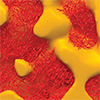Feb 01, 2024 (Nanowerk News) A research team led by Prof. LI Yue from the Hefei Institutes of Physical Science of the Chinese Academy of Sciences has introduced a self-confined solid-state dewetting mechanism. This innovation significantly reduces the reliance on complex nanofabrication techniques, paving the way for efficient wafer-scale patterning...
A positive spin-electrospinning and electrospraying synergism for the nanomaterials industry
Feb 01, 2024 (Nanowerk News) Combining these two twins-tech, electrospinning and electrospraying, to fabricate novel nanomaterials is an urgent area of research for materials scientists and biomedical engineers, according to a new paper by Professor Hu Jinlian of City University of Hong Kong (CityUHK) published in Matter ("Electrospinning and electrospraying...
Engineers unmask nanoplastics in oceans for the first time, revealing their true shapes and chemistry
Feb 01, 2024 (Nanowerk News) Millions of tons of plastic waste enter the oceans each year. The sun’s ultraviolet light and ocean turbulence break down these plastics into invisible nanoparticles that threaten marine ecosystems. In a new study, engineers at the University of Notre Dame have presented clear images of...
New low-temperature plasma technique unlocks flexible mesoporous metal oxides
Feb 01, 2024 (Nanowerk Spotlight) Mesoporous metal oxides (MMOs) – materials with tiny, interconnected pores – are coveted for integration in flexible electronics. Their high surface area lends utility across applications from energy storage devices to chemical sensors. However, reliably synthesizing MMOs has proven extraordinarily challenging. These intricate nanostructures typically...
Magnetic launching of black hole jets in Perseus A
Feb 01, 2024 (Nanowerk News) The Event Horizon Telescope collaboration, including scientists from the Max Planck Institute for Radio Astronomy in Bonn, Germany, has recently resolved the jet base of an evolving jet of plasma at ultra-high angular resolution (Astronomy & Astrophysics, "Ordered magnetic fields around the 3C 84 central...
Single proton illuminates perovskite nanocrystals-based transmissive thin scintillators
Feb 01, 2024 (Nanowerk News) Researchers from the National University of Singapore (NUS) have developed a transmissive thin scintillator using perovskite nanocrystals, designed for real-time tracking and counting of single protons. The exceptional sensitivity is attributed to biexcitonic radiative emission generated through proton-induced upconversion and impact ionisation. The detection of...
Nanoscale imaging method reveals new cells and structures in human brain tissue
Feb 01, 2024 (Nanowerk News) Using a novel microscopy technique, MIT and Brigham and Women’s Hospital/Harvard Medical School researchers have imaged human brain tissue in greater detail than ever before, revealing cells and structures that were not previously visible. Among their findings, the researchers discovered that some “low-grade” brain tumors...
Machine learning guides carbon nanotechnology
Jan 31, 2024 (Nanowerk News) Carbon nanostructures could become easier to design and synthesize thanks to a machine learning method that predicts how they grow on metal surfaces. The new approach, developed by researchers at Japan's Tohoku University and China's Shanghai Jiao Tong University, will make it easier to exploit...
Hydrogel platform enables versatile data encryption and decryption
Jan 31, 2024 (Nanowerk Spotlight) Hydrogels are crosslinked polymer networks that can absorb huge volumes of water. In recent years, significant progress has been made with so-called "stimuli-responsive" hydrogels - materials that change properties in response to environmental triggers like pH or temperature shifts. Clever integration of these dynamics has...
Groundbreaking genome editing tools unlock new possibilities for precision medicine
Jan 31, 2024 (Nanowerk News) A team of researchers at the Carl Gustav Carus Faculty of Medicine, University of Technology Dresden, led by Prof. Frank Buchholz, has achieved a major breakthrough in genome editing technology. They've developed a cutting-edge method that combines the power of designer-recombinases with programmable DNA-binding domains...










